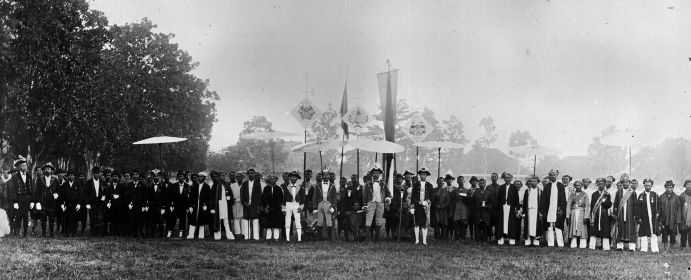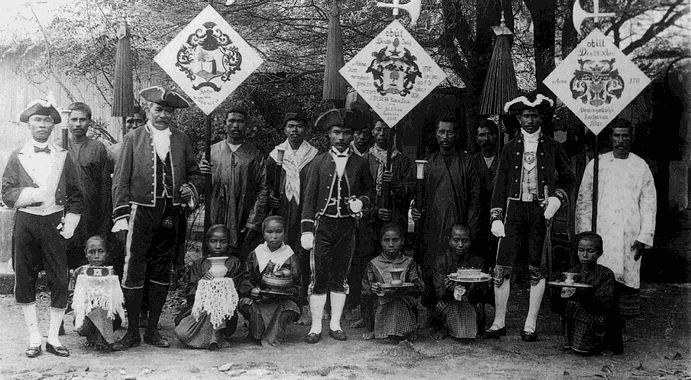According to the tradition, the history of the Pesulima Family starts
with the journey of three brothers from Java to Ambon. The Pesulima Family
originates from the eldest brother. His descendants spread over Ambon
and far outside it.
Nowadays Pesulima's live all over the world. In Asia, Europe and North
America we find our family members. The roots of all these people are
in Soya, up in the hills of Leitimur, the southern peninsula of Ambon.
Let's have a closer look into the story 'Origin/descent of the Pesulima
Family' that Mr. Gijs Pesulima wrote down in 1979. We are happy he
did so. His writings brought us the story that was probably told from
mouth to mouth by many generations. Grandfather Gijs, as family members
used to call him, died in 1985. We are very grateful for his efforts to
safe this part of the family history.
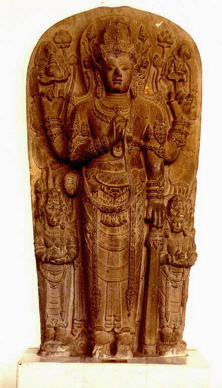 |
|
| A portrait
statue of Kertarajasa Jayawardhana, founder of Majapahit, from candi
Sumberjati, near Blitar. The statue is now preserved in the national
Museum, Jakarta. More about the Majapahit-kingdom at www.eastjava.com/books/majapahit. Used with permission of webmaster www.eastjava.com. |
|
King of Soya
The three brothers that arrive at Ambon are not ordinary travelers. They are princes of the hinduistic Majapahit-dynasty out of Java. (The kingdom of Majapahit, with its capital in East Java, flourished at the end of a period in which the religions of Hinduism and Buddhism were predominant cultural influences. It existed during the 14th century, Indonesia's so called 'Golden age'.) They choose three different places at Leitimor as their dwelling-places. The senior prince settles in Soya at the top of the mountain Sirimau. The second one resides in Nusaniwe, the third and youngest one in Kilang. The prince in Soya gets seven sons and a number of daughters. His eldest son was named Peseolima or Pesulima. This means: as the eldest son he was obliged to give guidance to his siblings.
In the negotiation with the in 1512 in Amboina arrived Portuguese, the senior of the three princes is represented by his youngest son Latuconsina, who rules over the region Honipopu. At that time, Honipopu is the sea port of the principality Soya. The Portuguese give Latuconsina the name Da Silva. (The rulers over the other principalities Nusaniwe and Kilang are respectively called Da Sousa and Da Queljoe.)
After the senior prince dies, Pesulima seems to be in charge. When the
Dutch arrive at Ambon in 1605, treaties are made with the rulers of Soya,
NusaniwÚ and Kilang. The king of Sirimau, Pesulima, does not take part
in the negotiations with the Dutch. He fears the eyes of the Dutch which
seem to be like cat eyes. Also the second sibling, Huwńń,
doesn't dare to face the eyes of the Dutch. Therefore the third sibling,
Rehatta, is sent. During negotiations later on,
the king of Soya (Pesulima) rejects the unfavorable proposals suggested
by the Dutch. As a result, the Dutch, with the might of weapons, declare
Rehatta as king of Soya.
Summarized one can say that the region around the mountain Sirimau, where
(among other places) Soya is situated, was ruled by the Pesulima family
centuries ago. When Pesulima did not want to agree with the suggestions
of the colonial occupier, Rehatta, who had the function of negotiator
with the whites, was declared king of Soya by the Dutch.
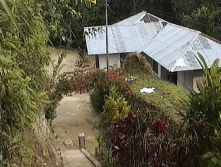 |
|
| The Pesulima House in Soya di Atas. Picture by Co Hulstaart, 1996, used with permission of Co Hulstaart. | |
For some time now the Rehatta family delivers the 'raja', the head,
of the village and the neighborhood (with some small villages) of Soya. On May 24th 2005 Johan Lodewijk Rehatta was elected as the raja of Soya.
However, in all important traditions at Soya,
the Pesulima family plays a prominent role. Pesulima is respected as one
of the most important families in Soya. Miss Rita Rehatta, daughter of
late René Rehatta, the former raja of Soya, says that members of
the Pesulima family always are present when traditional happenings take
place. This also becomes clear in the detailed report written by the German
scientist J. R÷der. He stays at Ambon during
January and February 1938, to investigate the history of Soya di Atas
(the old village Soya that is situated in the mountains).
In the surroundings of Soya one can find a number of old sacred places. At the southside of the village a meeting place (samurele) is situated. Via stairs that are cut out in the rocks you pass a standing stone to a man's height and three tiny stones, the keeperstones. These give access to the sacred place. There are also various rows of stones. These represent seats for the entitled families. The stones and the seats belong to the raja, the raja's wife, the Huwań (Huwae) family and the members of the Pesulima family. The seats are indicated as 'perahu', what means proa or boat. This term is connected with the grouping of the families in the boats, in the days that each family had its private 'kora kora'.
Yet higher, against the slope of the mountain Sirimau, an other sacred
yard is situated: the 'batu pemali'. Here one can also find a number of
ritual stones that belong to the raja, his wife, the relatives Huwań and
Pesulima, and the principalities Kilang and Nusaniwe that belonged to
Soya a long time ago.
At this place one can also find the sacred urn of Soya, the 'tempayang'.
It's always filled with water that can be used to drink or to wash parts
of the body. It is said that one, when using the water, can make a wish
and it will come true one day.
The tempayang at the slope of the Sirimau has been standing there for centuries. The writer Rumphius mentions the urn in his book 'Ambonsche landbeschrijving'. (Rumphius was employed by the Dutch East Indies Company and spent the greater part of his life on the island of Ambon.)
The history of the urn filled with water exists since the 'old times', as Rumphius writes in 'Ambonsche landbeschrijving'. The inhabitants of Soya attach supernatural powers to the urn. The Portuguese and later on the Dutch did not want to have anything to do with it and tried to banish the so-called superstition. Therefore chaplain Dominus de Brund, together with some elders, were sent to the urn, where they set the sacrificial house on fire, cut down the reedbush next to it and took the urn with them, according to Rumphius.
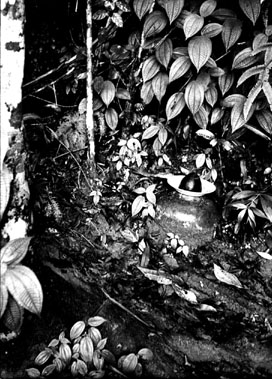 |
|
| The tempayang, the sacred urn of Soya, photographed by Mischa de Vreede and published in her book 'Geen verleden tijd' (1992). Used with permission of Mischa de Vreede. | |
However, violating the urn on the mountain Sirimau causes misfortune,
says 'Dominee Kam op bezoek in Soja', a publication of the teacher
training-college in Assen, the Netherlands. (Project bicultural education,
Marilah 10, 1982). In this publication, a story is told about three chaplains
who are said to have soiled the tempayang, the urn with water, in the
past. One of them is clergyman De Vreede
and it was told that he is being punished for it by the death of his wife.
Hendrika de Vreede-Bomers is the
preacher's first wife and she dies on October 30th 1926 at Ambon, where
she works at the time. She is only 27 years old.
De Vreede's daughter, the writer Mischa de
Vreede, pays a visit to Ambon in 1986, to clear up more in this matter.
She herself makes the trip to Soya to make inquiries about the history
of the urn. There it turns out that her father actually had a lot of respect
for the rituals and traditions of Ambon. He appeared, according to people
who knew him at Ambon, to be a man who always adjusted himself to the
customs of the country where he was. The novelist concludes from this
information that her father had probably not disturbed the urn. Then she
goes looking for the urn herself.
The raja of Soya, mister RenÚ Rehatta tells Mischa de Vreede that it goes
without saying that there is an urn filled with water at the top of the
mountain. 'Everyone that reaches the top is thirsty'. Anyone who drinks
the water and washes his face with it can count on good health and prosperity,
say travel brochures, in which the urn is mentioned as one of the rituals
of Soya.
When Mischa de Vreede climbs the mountain Sirimau, she also goes passed the sacred places. When reaching the top, she finds the seat of stone (surrounded by bamboo) meant for the raja. Behind the seat and the row of stones where the raja's wife and people of other important families take their places, she notices the urn: 'And then I see, delicately standing between beautifully leafed bushes, the tempayang. Halfway in the earth and intimate with a dish on it. So there it is... The niece (of the raja, eg) takes the dish away, takes some water, drinks it and washes her face with it. She gesticulates me to do the same: well, allright.' (De Vreede, 1992.)
Cuci Negeri, the cleanup of the countryThe cuci negeri, the cleanup of the country, is a practice that is probably being executed for centuries. In this usage, the area surrounding the urn is also cleaned. During the cleaning-ritual, the three families of Soya wind off a long rag of white cotton and go to the raja. Anyone who is quarreling is considered unclean and cannot take part. It is up to the raja to compose such feuds. Therefore, inhabitants of Soya who have problems come to the raja before the cleaning. In this phase, also the raja himself accounts for the work he did the past year. In the second phase, everything gets cleaned-up: the whole 'negeri'. The third phase is the symbolical cleaning: united by the white rag, the clans gather with the raja to emphasize their unity. They pray and sing. The raja of Soya, RenÚ Rehatta, also considers the rituals as a preparation for Christmas and the new year. The complete festivity of the cuci negeri lasts two weeks. (De Vreede, 1992.)
R÷der describes in a more detailed way how the annual ritual is executed.
In earlier times, both sacred places, the 'samurele' and the 'batu pemali',
were the places where extensive ceremonies were held in December. During
this big adat-feast, young men were consecrated in manhood. They had to
fast for five days. On the last day, they get a tattoo on their forehead,
their breast or their stomach. Meanwhile, the samurele and the village
are cleaned by the women and the elderly: the cuci negeri.
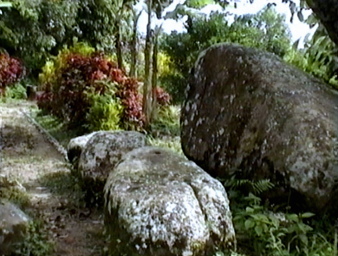 |
|
| The raja's stone seat in Soya di Atas. Picture by Co Hulstaart, 1996. | |
The raja and his wife, together with the representatives of the Huwań
- and Pesulima family, gathered with the batu pemali. R÷der continues:
'The raja sat down on the flat stone and looked towards the west. His
wife stood behind him, while Hoewa and Pesoelima took their places on
the two stones on the side. The raja raised the spirits of Latoe Sirimaoe
and Veri-ina. Hoewa and Pesoelima saw the raja and his wife as the mythical
ancestors who had come to life again, and they addressed a prayer to them.
Then came the youth of the tampat naga and went, together with the raja,
to the Samoerele, where the families already sat down on the stones in
their 'perahoes'.' After that, the old, sacred songs were sang. 'The raja
ascended the already described seat of stone and from there, with his
eyes towards the mountain Sirimaoe, he spoke of the ancestors' great deeds.
All people got up and two old women of the raja's family put a white ribbon
around all people, which meant that they formed a unity, in one big 'perahoe',
in the village community. They grasped the ribbon and made rowing-like
movements.'
The author ends with the remark that the festivity has been shortened
over the years, which had as a consequence that certain ceremonies were
maintained no longer, but he thinks it is a miracle that, despite the
foreign influences of centuries, 'the old still exists so strongly and
lively'.
At that time, the inhabitants of Ambon deeply respect the tradition of Soya. Even the city of Ambon, according to a German researcher, fears Soya's ancestors: whenever a disease breaks out or misfortune is threatening, people go to Soya to make sacrifices and to beg the ancestors' forgiveness. David Mearns (1999) emphasizes the strong cultural identity of Soya: 'Soya was one of the major pata siwa communities of the island of Ambon and had their own language, belief systems and myths of origin which include stories of the arrival of Javanese nobility in the period of turmoil in the central Javanese kingdoms at the end of the fourteenth century.' Soya was 'a community with a sense of its own noble origins and a distinctive cultural identity.'
Both from the oral tradition as from this story, it appears that in the course of centuries, the Pesulima family was ranked among the most prominent families of Soya.
For those who are interested:An inhabitant list of 1733
The fact that for centuries Soya has been the home of the Pesulima's,
was confirmed again in 1997, by a remarkable finding. I came across three
inhabitant lists of Soya, of the years 1732, 1733, and 1734.
The lists are found among a great amount of books and documents in the
huge VOC archive of the General State Archives (ARA) in The Hague. The
one of 1733 is most clearly legible, and it is presented under the title:
'Description of the soles of all natives, their families and their clove
trees'. In the statement of 'The village Soya up in the Mountains', three
Pesulima's are recorded. Between Guilliaan Patty, Thomas Latumanussey,
Domingos Ririmassa, Ealat Eipessi, Louis Eohoery, Jacob Latoemaloe, Cornelis
Tamatelahitoe, Cassoer Sopolanit and others, we indeed find the names
Alexander Pessoelima, Atta Pessoelima and Cornelis Pessoelima. Except
the names, also the number of family members (men, women and children)
of a household are recorded, together with the number of clove trees which
the family in question owned. The household of Alexander consisted of
six men, three women and nine children. Atta's family consisted of two
men and one woman. Perhaps he lived together with his wife and an adult
son or maybe one of their fathers lived with them? Cornelis, to end with,
had a household of three men, one woman and one child.
How can it be that there are inhabitant lists of such a small town on
Ambon around 1733? A short piece of history of Ambon:
From 1605 on, The 'Verenigde Oost-Indische Compagnie' (VOC) (Dutch East
India Company) constructed a trade monopoly, which mainly runs on buying-up
and selling cloves. The cultivation of cloves had been moved from the
northern islands of the Moluccas, like Ternate, to the Ambonese islands:
Ambon, Haruku, Saparua and Nusulaut. Only in this area, since 1655, it
is allowed to produce cloves. This trade makes big profits. At the end
of the 17th century, however, there is a state of overproduction. The
warehouses are full, the stock is bigger than the demand. Yet, about 1727,
there is a shortage of cloves on the world market again. Then, the VOC
commands that certain amounts of clove trees have to be planted on the
islands.
Keeping an accurate administration of the number of clove trees per household,
has probably been an attempt of the VOC to control the number of cloves
produced. For that reason also, it was determined that village leaders
had to promise to agree with destroying the trees whenever there was a
state of overproduction again.
Five ancestors
In the papers that were written presumably by Gijs Pesulima from Ambon,
there also was a part of a Family Tree of Putri Peseulima and her five
sons.
Judging from the information in this overview we can assume that the sons
of Putri Peseulima were born about the year 1790. This can be concluded
from the fact that, according to the papers, the first three sons served
in the British army. Such an army corps did exist during the so called
second British interregnum from 1810 till 1817. After a domination by
the Dutch during two hundred years, a time comes that the British are
the rulers in Indonesia for up to two times. The British rule over Ambon
during that period is characterized by a certain mildness, compared to
the Dutch rule. Ambonese young men that serve in the army during that
rule are not forced to go to the far Java. Therefore there is enough interest
to join the corps, that exists of 400 most Ambonese soldiers.
When the Dutch restore their rule over Ambon in 1817, they are given the
opportunity to take over the Ambonese corps, but they reject this proposal.
Short before the authority is carried over to the Dutch, the British give
the dismissed soldiers the position of civilian. Thereby they are free
from statute labour.
It is possible that during this period of change many took the opportunity
to build a new life somewhere else. Maybe in these years Pesulima's moved
to other places. The information mentioned below in fact confirms this
assumption.
Putri Pesulima and her five
sons
The Family Tree starts with the name of Putri
Peseulima, pronounced as Pese-ulima. Putri means princess and daughter,
an other first name is unknown. The sons have their mothers surname: Pesulima.
The Dutch administration forbade a marriage to the Dutchman with whom
she had a relation, as appears from the document. Another source mentions
a Dutchman from German origin, with the rank of an officer who is working
in the administration. His name unfortunately got lost during the transmission
from generation to generation.
That raises the question why the Dutch government did forbid the marriage
of Putri Pesulima to the Dutchman. According to Willems, W. e.a. (1997)
both the VOC and the church didn't allow a European to marry a not-christian.
Moreover a marriage was allowed only when the partner speaks the Dutch
language in some measure. Europeans on the other hand were
not expected to turn back to Europe after marrying a local christian woman.
The Dutch government stimulated marriages between European men and Ambonese
women. Not just to oppose the regular occurring concubinage, but also
to connect the 'compagnie' and the local population.
Then we come to the five sons of Putri Pesulima. The explanation to the
eldest son, Augustus, unfortunately is very badly readable. Frederik,
the second son settled down at Hattu, according to the papers. There,
the surname changed into Peculima. (I've talked
to some persons with the name Picaulima whose ancestors come from Hattu.
Unfortunately, they do not have any knowledge about the link between the
names Pesulima and Picaulima.) What is written about Hendrik, the third
son, is that his descendants live in Galala, Hatiwe Kecil, between Halong
and Passo and at the North Moluccan island Ternate. The lineage in Lokki
in West Seram is formed by the descendants of Johanis, the fourth son.
His descendants also live in Tawiri and Silale/Latuhalat. The offspring
of the fifth son Jacob lives in Soya, Rutong and Waai.
The descendants of these five men that settled down at different places,
make the separate lineages of the Pesulima family. As far as we have found
information about these lineages, this information is presented in detail
in the single lineages at the page Genealogy.
There, you also can read the original text about Putri Pesulima and her
sons.
To the Netherlands
In 1951, circa 12,500 Moluccans were transported from Java to the Netherlands. They were mostly soldiers who had served in the Dutch colonial army (KNIL), and their relatives. Among them were many members of the Pesulima family.
Overview
| Ship | Fam. name | Maiden name | Initials | Sex | Role in family | Date of birth | Army rank |
| Roma | Pesulima | W.J. | male | householder | 1923-01-17 | soldaat-1 | |
| Roma | Pesulima | - | - | female | wife | - | |
| Roma | Pesulima | P. | male | son | 1943-12-09 | ||
| Skaubryn | Pesulima | D.S. | male | householder | 1913-01-05 | 1e luitenant-legerpredikant | |
| Skaubryn | Pesulima | Puturuhu | C.M. | female | wife | 1919-07-05 | |
| Skaubryn | Pesulima | L.M. | female | daughter | 1941-04-13 | ||
| Skaubryn | Pesulima | J. | male | son | 1943-12-06 | ||
| Skaubryn | Pesulima | E. | female | daughter | 1945-12-25 | ||
| Skaubryn | Pesulima | E. | female | daughter | 1947-08-19 | ||
| Skaubryn | Pesulima | D. | male | son | 1949-05-23 | ||
| Skaubryn | Pesulima | S.A. | male | son | 1951-01-01 | ||
| Castel Bianco | Pesulima | J. | male | householder | 1927-01-03 | soldaat-2 | |
| Castel Bianco | Pesulima | - | - | female | wife | - | |
| Skaubryn | Pesulima | B. | male | householder | 1921-01-06 | soldaat-1 | |
| Skaubryn | Pesulima | - | - | female | wife | - | |
| Skaubryn | Pesulima | - | female | daughter | 1948-10-03 | ||
| Skaubryn | Pesulima | - | male | son | 1950-08-26 | ||
| Fairsea | Pesulima | Th. | male | householder | 1914-03-13 | sergeant | |
| Fairsea | Pesulima | Siwalette | C. | female | wife | 1931-10-25 | |
| New-Australia | Pesulima | B. | male | householder | 1920-04-12 | soldaat-2 | |
| New-Australia | Pesulima | - | - | female | wife | - | |
| New-Australia | Pesulima | E. | female | daughter | - | ||
| New-Australia | Pesulima | - | female | daughter | 1948-04-22 | ||
| New-Australia | Pesulima | - | female | daughter | 1950-10-03 |
* Source: National Archives of the Netherlands, The Hague (Nationaal Archief).
